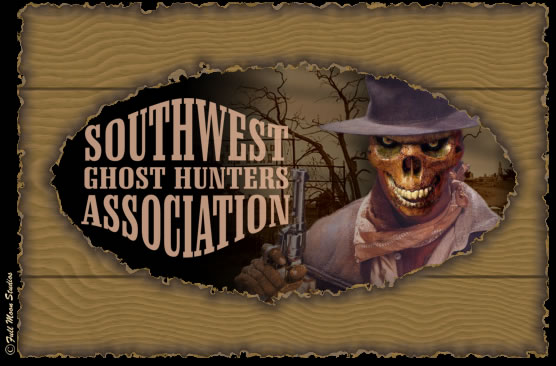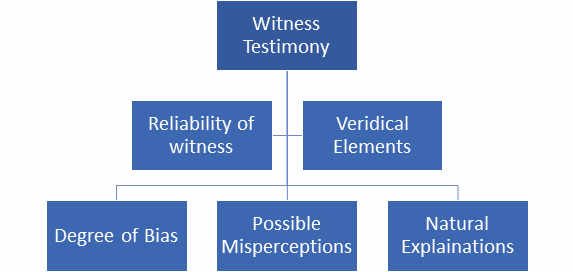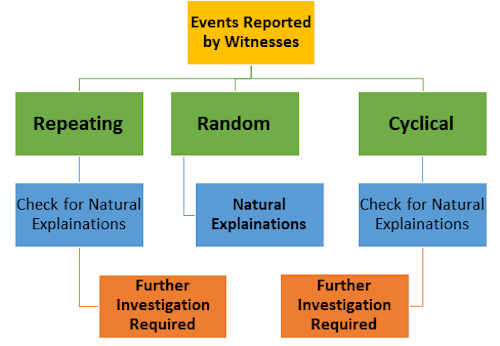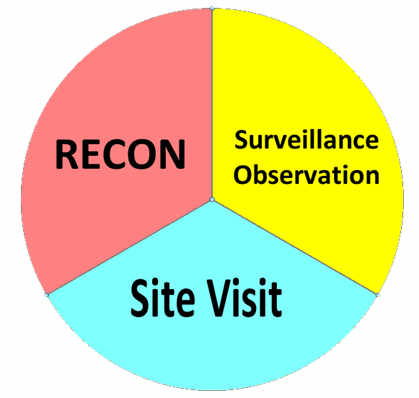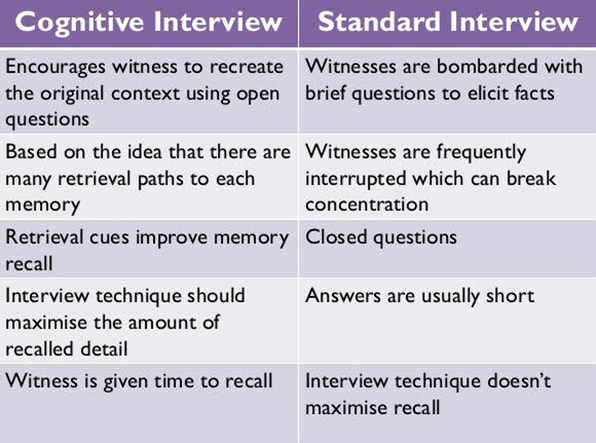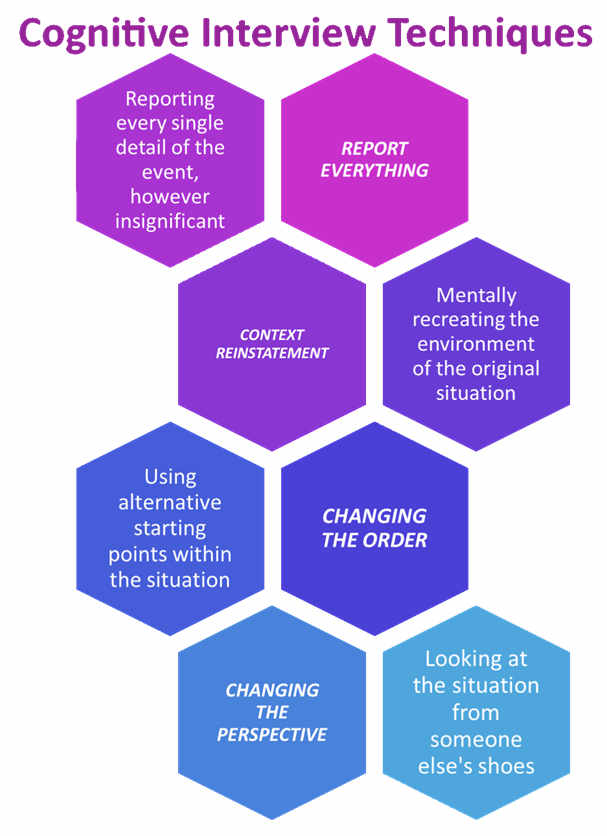The process used by SGHA for ghost hunting is designed to eliminate investigator bias and to attempt to solve the mysteries provided by haunted locations. The process has several different phases, each with its own steps, which must be completed fully in order to obtain useable data.
The basic ghost hunt can be conducted in a variety of ways with multiple objectives. This SOP covers the basic overview of the ghost hunt and defines regulations and standards for the SGHA. Ghost hunting is the process of investigating locations that are reported to be haunted by ghosts. Typically, a ghost hunting team will attempt to collect data on paranormal claims and search for alternative explanations. Ghost hunting by itself is not an efficient way to conduct paranormal research and is considered to be a hobby by SGHA.
1.1 The Gurney/Myers Standard for Ghost Investigations
Well-organized, systematic studies of apparitions started after the Society for Psychical Research (SPR) was founded in England in 1882. The SPR was soon joined in this quest by the American Society for Psychical Research (ASPR) and by smaller research groups and individual investigators in continental Europe. Scholarly journals were established to publish ongoing research as well as theoretical speculation and fierce debates. The basic idea of these efforts was to apply scientific method to data collection, evaluation, and interpretation of psychic phenomena – an area which nineteenth-century materialistic science had ignored up to that time. Advertised appeals brought an abundance of material, much of it reported in the Proceedings and Journals, leading in 1886 to the publication of the voluminous Phantasms of the Living. This was followed by a landmark Census of Hallucinations, whose findings were published in the Proceedings in 1894.
It was a pioneering survey, 17,000 respondents were contacted. The reports were analyzed and published in several major works. The main analysis done by Edmund Gurney was published in two volumes called Phantasms of the Living. Other important were written by Gurney et al (1886) and Myers (1903). Several other collections appeared later, such as those by Bennett (1939), Green and McCreery (1975), Jacobson (1973), and Jaffé (1979). With the benefit of hindsight, several conditions pertaining in the late nineteenth century can be seen to have been peculiarly conducive to research into ghostly phenomena.
The simple fact is that they discovered that 70 to 90% of all reported cases of ghostly phenomenon are actually explainable. Additionally, they used the information they uncovered to create a classification system for the reported accounts of hauntings. The classifications they created consist of only two types, “Low Grade” and “High Grade”.
Low Grade (explainable):
Apparitions are most often reported by “fantasy-prone” persons, the 4% of the population who are good hypnotic subjects, have vivid imagery skills, and who report a wide range of other psychic and or paranormal experiences. Low Grade cases/observations are often explainable by one or more of the following factors.
- a) Misperceptions
The report has little merit, being based on distortions of perception (e.g., because of poor light, short duration, pareidolia), and on emotional exaggerations. Hoaxes can be common, especially for ghost photographs. Misperception is misinterpreting something seen, heard, felt or otherwise sensed. Misperception alone accounts for most of the reported paranormal experiences.
- b) Imagery or Hallucination
The witness, often psychic or a suggestible person unconsciously generates an apparition as a response to suppressed needs or beliefs. The source of the impressions would be the conscious or unconscious mind of the witness, or more speculatively, archetypal images from the “collective unconscious”.
An old variant is the model of Gurney (1886) and Tyrrell (1953), now called the super-ESP hypothesis; the apparition is at least partly composed of telepathic data that is then projected out from the mind of the witness. Louisa Rhine found that input of data from outside was unnecessary in all but one of 8000 reports; apparitions were hallucinations created totally within the mind (Falsidical Hallucination). The most typical examples of Falsidical Hallucinations are moving shadows (Shadow people) and fleeting images typically lasting less than two seconds. It is important to understand that the witness did actually have an experience and will strongly believe so, however the experience is explainable. A measurement of the witness’ bias (belief) towards the paranormal can often correlate directly to the potential of experiencing a Falsidical Hallucination. The hallucination may also trigger the fight or flight response in the witness.
- c) Myth Building and hoaxes
The account of the phenomenon is comprised of second and third hand accounts. There are no direct witnesses to the reported paranormal activity. Myth building is the elaboration of elements in a story. These elements may have some degree of truth while others may be completely false. It is the essential building blocks used in the construction of myths and urban legends.
The designation suggests nothing about the story’s veracity, but merely that it is in circulation, exhibits variation over time, and carries some significance that motivates the community in preserving and propagating it. Essentially, it is nothing more than a ghost story.
High Grade
High Grade observations include veridical information that is revealed to the witness/witnesses about the apparition’s appearance. Details such as specific clothing, facial/body features, injuries, movements (having a distinct walk or limp) and smells (such as the distinct smell of specific lady’s perfume that the deceased person wore in life) that can be confirmed or compared with the reports of other witnesses is vital. Other elements which can make an observation High Grade include;
- They reappear in the same place over time to different witnesses. The phenomenon repeats behavior.
- The apparition is seen in a specific location (the place of death or a great tragedy) and if veridical information from that sighting is later verified as factual about the deceased, such as matching their description with an old photograph, being told who killed them, the location of valuables, or specific phrases known being uttered which matches their personality that known only to living relatives/friends.
- Observations where multiple people, either together or independently, describe the exact same details of the phenomenon they have witnessed. This is especially important if they had no prior knowledge of the location or its history. If the apparition is unknown to the witness at the time of the sighting but was identified by other means that identifies it as a factual person. This may have been obtained through historical research or when the witness or witnesses speaks to other people like relatives and friends, or sees them in a photograph.
- The apparition either directly tells them or shows them something important (a family secret, a lost will, how they died, who killed them, etc) that is later independently verified to be true.
- The duration of the sighting is over three seconds and the witness can make out enough visual details to provide a good description.
The above types of Veridical Encounters highly suggest that when you examine them, many contain strong veridical elements aside from merely “seeing a ghost”. However they are very rare and the burden of proof is harder to obtain, as these are subjective experiences. “Grading” cases and observations and understanding the results of prior research is a vital part in examination of paranormal claims as it dictates the direction and methodology an investigator should use to examine the available testimony and evidence to reach a conclusion. Low Grade cases are often explainable by properly identifying the reported phenomenon as natural or manmade in origin. High Grade cases are much more difficult to tackle and will present more of a challenge.
How to use the standard
The basis of the standard is actually quite simple. We do not know what ghosts are or even if they exist. If you do not know what something is, then how are you going to look for it? The standard takes an approach of eliminating the known factors that can be identified and accessed in validity. While it cannot be used to prove a haunting, it can be used to eliminate the common factors that create legends and myths.
The standard analyzes three key elements that have been identified through the previous inquiries by SPR.
- Witness Testimony
The most important aspect of any investigation is to obtain, as far as possible, a detailed and accurate picture of the events. This usually means conducting in-depth interviews with the people directly involved and possibly with other relevant witnesses. The standard requires that the testimony of the witnesses be examined for veridical elements. Misperception, natural explanations and degree of bias must be considered as alternative explanations.
At the outset, you need to record the details of the witnesses: name, age, contact point. If the case appears promising, it is important to obtain signed statements from witnesses and experiments. It may be necessary to note down what the interviewee says, and compose a statement from the notes, or make a transcript of a tape-recording. In such a case, the interviewee should be asked to read the statement and to make whatever corrections and additions s/he desires before s/he signs it.
Before witnesses are invited to make statements, they should be assured that their names will not be published without their consent, and that, in the event of publication, pseudonyms will be used if so desired.
The relevant information to be collected would include items such as:
- time and date at which the experience took place and the duration of the events concerned;
- what the witness was doing and their state of mind at that time;
- whether the witness has had a similar experience before;
- the circumstances – (where appropriate) how well the scene was lit (if the experience was visual) and what sounds were heard (if the experience was auditory), what else was happening at that time;
- if other people were in the household, where were they during the experience;
- an impression of the health, education, interests and reliability of witnesses (there are usually plenty of clues in people’s behavior, relationships and surroundings).
Where this is appropriate, the scene of the alleged paranormal events should be visited as soon as possible, and a record made of the relevant information.
- Event Occurrences
There are two types of spectral phenomena that was identified in previous studies, REPEATING and CYCLICAL. Repeating manifestations are those in which certain behaviors repeat over time. There is often no apparent pattern, only that the same instances occur repeatedly. Cyclical manifestations are those that manifest themselves on or near a certain time(s) of the year.
- Historical Research and literary review
The purpose of historical research is to check any associated facts to determine their validity and to assist in determining the degree of myth building. Often myths are identified just by checking out the history of a location.
2.0 The planning process
Before the research can executed, the Officers and Team Leader (if one is appointed) must have a planning meeting to sort out details, assign or delegate responsibilities and to determine what techniques/ experiments are going to be used. It should be noted that when an Officer delegates a specific responsibility, they are still held accountable for that responsibility.
The Officer’s responsibilities are as follows.
Operations Officer
- Determine which techniques or experiments are going to be used
- Develop a plan to ensure that there is enough allotted time for experiments and to adequately search the location. Other factors, such as breaks, meals and travel time need to be considered.
- Determine how many people are needed to carry out the operation based on its size and the amount of time the Team has access to the location.
- Post the ghost hunt in the forum to determine which ghost hunters are available for the ghost hunt. Try to give at least two weeks of notice to allow members to adjust their personnel schedules (coordinate this with the Admin Officer).
- Determine if additional (rented or borrowed) instrumentation is required. Coordinate this with the Admin Officer.
- Determine what controls are necessary for the ghost hunt.
- After the Team is chosen, assign a Team Leader (optional). If no Team Leader is chosen, the Operations Officer will act as the Team Leader.
Logistics Officer
- Inspect equipment and instrumentation prior to leaving to ensure serviceability (Batteries, calibration, condition)
- If instrumentation is to be rented or borrowed, make any needed arrangements (payment, pick up and drop off). Inspect instrumentation before and after the ghost hunt.
- Make travel arrangements for the Team (carpooling, etc.) Designate a place and time for the Team to meet up before the ghost hunt.
- Ensure hotel arrangements are made (if needed) and know the room numbers of the team members.
- Charge batteries for cameras (if required)
Admin Officer
- Arrange a date, place and time for the planning meeting of the Officers.
- Advise the Operations Officer on member participation, training levels and special skills.
- Prepare enough blank forms for team members to record information during the hunt
- Type up the final plan and print a copy for the Operations Officer and Team Leader.
Vice President
- Assume the responsibilities of any Officer not available for duty. Will often preside as the Team Leader for the ghost hunt.
- Preside over the Officer’s planning meeting.
- Make the final determination and approval of the plan.
2.1 Overview of the Officer’s Planning Meeting
The Officer’s planning meeting is held to determine the following.
- Determine primary objectives of hunt (e.g. EVP’s with verifiable facts, monitoring a room with repeated activity, etc.)
- Are additional resources needed? (Instrumentation, rentals)
- Which members are participating in the ghost hunt (compose the Team). Ensure that the Team is balanced (experience and skills) and that the members are selected fairly.
- What controls are required for the Ghost Hunt and how they will be maintained (define).
- Assign duties for participating members.
- Implement a schedule that moves teams from location to location at regular intervals and allows for periodic breaks for each of the teams. In certain instances, the team may be mobile and not stationary. In this case, the team moves from one place to another and calls any information back to a team stationed at the base.
- Identify problems with the operational plan and correct them.
- Approve and implement the plan.
- Schedule post hunt data review
2.2 The types of Ghost Hunts
SGHA employs three different types of “ghost hunts”. Each has its own objectives and tasks. Ghost hunts differ from investigations because several elements of the reported phenomenon have met the Gurney Myers Standard. This requires a more in-depth analysis of the location and the witnesses of the phenomenon.
The ghost hunt’s primary purpose of investigating the witnesses sighting is to discover alternative (explainable) causes for the phenomenon and replicate the experience. Make every attempt to re-create the event and give serious thought into what could have caused it. This is something that should not be rushed and done care by conducting various observations from different prospective.
2.2.1. Recon
A recon ghost hunts is basically an initial look at a suspected haunted location. It is the first step in our operational process. The goal of the recon is to obtain more detailed information about the location and forward that information to the President for review. A recon can be initiated any member of SGHA. Typically these hunts only require no more than two people. Ideally, the recon needs to address three things.
1.) Are there paranormal claims about the location? If so, what are they?
2.) Are there witness to the phenomenon? Can they be contacted?
3.) Can SGHA conduct a ghost hunt or investigation at the location?
Finally, the location should be photographed well. Be sure to include the areas where the paranormal claims were reported. Tour the location taking photographs of any key areas in question and of the location as a whole from various angles, When it comes to reviewing it is vital to have photographs from a different views it might help with identifying alternative explanations.
2.2.2. Surveillance/ Observation
Surveillance and observation hunts are initiated if the location has met the requirements of the Gurney/Myers Standard. Now the team is going to investigate the claims more thoroughly.
The ghost hunt must remain as specific as possible to the paranormal claim being presented by the witness. Search for alternative explanations for paranormal claim by examining the surroundings and environment. The most common explanation is often misperception of quasi-normal events by the witness. Quasi-normal Events are explainable phenomenon that happen rarely or that happen under the right circumstances. Care should be taken to observe the area under the exact same conditions as the witness when he or she had their experience.
The first step is to interview the witnesses of the reported activity. SGHA uses the cognitive interview technique. This is explained in more detail in Section 4 of this SOP. The cognitive interview (CI) is a method of interviewing eyewitnesses about what they remember from a paranormal event. Using four retrievals, the primary focus of the cognitive interview is to make witnesses of a situation aware of all the events that transpired. Ideally, the interviews should be conducted at the place where the witness had their experience and must include detailed questioning about the environment so that it can be replicated later. (lights on or off, Noises that were present, etc). Imagine that you are a film maker and you want to replicate the event is such detail that the witness can say that it was EXACTLY the way it was the night of their encounter.
Sometimes, reconstructing events at the original site can lead to a normal explanation of the event. Suppose, for instance, that a weird groaning noise was heard by one of the ghost hunters in an old derelict building. Upon further examination, it was discovered that the wind produces just such a noise when it blows through the building from a particular direction. Other odd noises or smells could be produced by animals or nearby vegetation. The ghost hunter should follow where the facts lead. Often those facts will lead to explanations with a basis in a natural cause.
After the witness interviews and reconstructions are done, the team is ready to start the surveillance. The team members will put themselves in the position of the witness as much as possible in an attempt to identify any possible phenomenon that the witness may have misperceived as paranormal.
The basic principle of conducting surveillance is to split the ghost hunters up into teams of two or more. Each team is then stationed at a particular location. Anything change in the environment is written down and recorded. The rotation schedule moves teams from location to location at regular intervals. Breaks are also scheduled to allow the investigators time to rest.
The teams are moved to put fresh eyes at each location and to prevent boredom. It is important that a single ghost hunter is never left alone unless it is specified in the plan. This is done to prevent psychosomatic response and misidentification of natural causes of phenomena. If remote monitoring is employed, two ghost hunters should watch the monitor at all times unless the plan specifically states to record the cameras without monitoring. This may be done if the investigation is short on manpower. If the cameras are monitored, anything unusual seen on the monitor must be reported to the team leader immediately so that it can be investigated as soon as possible. The monitoring station should be set up in the established base area so cameras can be checked if an event is radioed in by any of the surveillance teams. Additionally, two ghost hunters need to be assigned to a “stand-by” team. This team is deployed at the base station and if a significant event is reported, the standby team proceeds to that area to investigate the occurrence.
Create a hypothesis of the phenomenon
After investigating the event and performing observations of the appropriate areas where the event occurred you will have some ideas as to what could had caused the phenomenon to be seen as a genuine paranormal. Was it misperception by the witness? Is fakery a possibility or perhaps it was something environmentally that occurred that was unknown to the witness.
Create a hypothesis of the events with ways to test the hypothesis with the equipment and knowledge that you have. Record the methods that you will be conducting in your tests, including the steps you have taken to understand the event.
The hypothesis must be testable, taking into account current knowledge and techniques, and be realistic. A hypothesis must be verifiable.
Test the hypothesis
Test and record your hypothesis then examine the results. Was the phenomenon replicated successfully? If so, repeat the test again. If the results are identical the you have a strong alternative explanation for the reported phenomenon
If you were not able to replicate or find reasoning for such phenomena then the event will be classified as “unsolved”. The location will be become a longitudinal study
2.2.3. Site Visit
If the findings from the Surveillance/ Observation ghost hunt are still inconclusive, SGHA will began launching site visits. These ghost hunts are basically longitudinal studies in which data is gathered for the same subjects repeatedly over a period of time. If a location is really haunted then the investigation of future events may yield some information to further the case. If the phenomenon still cannot be replicated and further reasoning of the phenomena does not suggest an alternative explanation then the goal is to try and capture this objectively which will give validation to the claim by the witness.
3.0 Regulations on Ghost Hunting
After the team arrives at the location, the equipment must be inspected and prepared. Equipment on a ghost hunt serves two purposes. One is that it eliminates natural causes, for example, a video camera would see anyone interfering with an object that is supposed to move by itself. The other is to actually record phenomena. The instruments must be positioned where they cannot move. Try to deploy instruments close to each other if at all possible.
After the instruments have been deployed, the Team assigns an area as the base station and has a final briefing on the objectives of the investigation and the protocols assigned to the location. Additionally, the following regulations must be met.
3.1 Team composition/ Pre-planning
- Team size is limited to 6. Additional ghost hunters require the deployment of another team or dividing the present team into two smaller teams.
- All team members must attend the pre-hunt briefing and understand their assignments.
- Team members are required to participate in the data review after the ghost hunt is completed.
- All equipment that is used by the ghost hunters (meters, cameras and such) must be inspected and have an operational check performed. New batteries are required in all instrumentation.
3.2 During the ghost hunt
- If possible the team is locked inside the building. All doors and windows must be secured. This is to prevent any interference from outside sources. In the case of an outdoor ghost hunt, the perimeter of the area must be monitored or secured in some fashion.
- All personnel must be accounted for at all times. This includes authorized by-standers such as building owners and employees. All team members need to have radio communication with the base station.
- Movement around the location is controlled and monitored. The Team Leader must approve any deviation from the assigned positions or unauthorized movement. Positions of the Team and approved movement around the location are briefed to the team during the pre-investigation briefing.
- A single investigator should never be left alone unless the plan warrants it. (the Wingman Rule)
4.0 Interviewing the Witnesses
The most important thing that ghost hunters do is to properly interview the witnesses of a paranormal claim. Witnesses of paranormal phenomenon are interviewed using the Cognitive interviewing technique. Cognitive interviewing is a technique used to provide insight into learners’ perceptions in which individuals are invited to verbalize thoughts and feelings as they examine information. Essentially, they are “thinking out loud” as the interviewer is guiding them through the interview.
4.1 Interview Tips
- Allow enough time so that the pre-interview and cognitive interview are not rushed. More complete and in depth responses to fewer questions will be more useful than minimal or less in depth responses to more questions.
- Provide non-verbal reinforcement to let the interviewee know that you are listening, such as nodding your head, saying “hmm mmm” and saying “okay”, or “I see”.
- Encourage the interviewee to provide specifics about what s/he is thinking.
- Use the following prompts if the interviewee appears to be having difficulty thinking aloud:
“Tell me what you’re thinking.”
“What are you thinking about right now?”
- If you have a note-taker available, have him/her record items the interviewee talks about during the pre-interview and cognitive interview, such as details, activities or questions s/he answered, and put quotes around words/phrases used by the interviewee.
- Instruct the note-taker, if applicable, to record non-verbal actions the interviewee displays while looking over the materials, such as fidgeting, picking at fingernails, twirling hair, appearing distracted, etc.
- Debrief with the note-taker, if applicable, to verify that all information is complete.
4.2 Conducting the Pre-Interview: Introduction and Warm-Up
The purpose of the pre-Interview and the warm up is to train the interviewee on how to “think out loud” while being asked questions about what they experienced. The warm up uses a pamphlet. The pamphlet can be on any subject.
Introduction
“Thinking aloud may be new and unfamiliar to you, but please know there are no wrong answers. I am only interested in knowing what is going through your mind. Any information you provide during this pre-interview will not be used in the project; this session is merely to help you become familiar and comfortable with the ‘think aloud’ process.”
Warm-up
“Before we begin the actual pre-interview, I’d like to ask you a ‘warm-up’ question to introduce you to the think aloud process.”
“Try to visualize the place where you live, and think about how many windows there are in that place. As you count the windows, tell me what you are seeing and thinking about.” (Willis, 1994)
The next warm up exercise involves a pamphlet. The pamphlet can be on any subject.
“ I’m going to show you a pamphlet. Take as much time as you need to look over the pamphlet. As you look over the pamphlet, I will ask you some questions about what you are thinking. I will be taking a few notes during the session. This will help me remember what you said.”
“Feel free to comment or ask questions as you look over the pamphlet. I did not design the pamphlet and you will not hurt my feelings, no matter what you say. There are no wrong answers. What questions do you have before we get started?”
- Hand the physical activity pamphlet to the interviewee and proceed with question 1
Question 1
“Please look over the pamphlet. Take as much time as you would like to look over the pamphlet. As you are doing this, tell me out loud any thoughts that go through your mind.”
| If the interviewee: | You may respond: |
|
Asks what s/he is supposed to do |
“I am interested in what you are thinking as you look over the pamphlet. Do whatever you need to help you think aloud about the pamphlet.” |
|
Appears to have difficulty thinking out loud |
“Tell me what you are thinking.”
“What thoughts are going through your mind right now?” |
|
Is thinking aloud with no difficulty |
“That’s great. Thinking out loud like this is just what I need.”
“Good. Your comments help me understand what you’re thinking about.” |
Question 2
“What other thoughts came to mind while you were looking over the pamphlet that you haven’t shared?”
If the interviewee appears comfortable thinking aloud, proceed to the Closing after the interviewee has completed question 2.
- If the interviewee is having difficulty thinking aloud or did not share many thoughts, continue with: “Now, I’d like to show you another pamphlet.”
- Hand the other pamphlet to the interviewee and continue with question 3.
Question 3
“Please tell me out loud any thoughts you have while looking at the pamphlet.”
- Wait until the interviewee has completed looking over and sharing any thoughts about the pamphlet, then proceed to the Closing section.
Closing
“Thank you for taking time to talk with me. What questions do you have?”
- Answer any questions
4.3 Conducting the Pre-Interview: Introduction and Questions
The pre-interview is used to help determine biases and other information on the witnesses’ worldview and the quality of their observation.
Introduction
“I’m going to ask you some general questions that will help me understand your worldview on certain subjects. These are simple, straight forward questions.”
1.) Do you believe in ghosts / paranormal (Bigfoot, UFOs)?
2.) Have you ever had a paranormal experience before this?
3.) Did you know that the location where your experience occurred was haunted before your experience? (what stories did you hear/ From whom?)
4.) When the “paranormal” event occurred, what was the very first thing that you thought it was?
5.) Why do you believe that your experience was paranormal?
6.) How did you feel just before and after the event?
- Alert?
- Busy doing something?
- Emotions
- Thinking about something, distracted?
7.) Do you have good eye sight and hearing or do you require aids?
8.) Would you say that you religious or spiritual?
9.) Were you drinking coffee or energy drinks before your experience? (If so, how much)
10.) Are you taking any kind medication for anything (including aspirin) before the event?
11.) Have you watched any TV shows on the paranormal? Which ones? What did you think about them?
4.4 Conducting the Cognitive Interview:
Introduction
“Thank you for participating in this cognitive interview. Your feedback will help us learn more details about the phenomenon you encountered. I will be tape recording the interview. Do I have your permission to record the interview?”
- If yes, start the tape recorder and read the consent form (Appendix B) to the interviewee.
- If no, read the consent form to the interviewee.
“The interview format will be the same ‘think aloud’ process that we used in the warm up interview you participated in earlier. What questions do you have before we begin?”
- Answer any questions.
“Please remember that there are no wrong answers. I did not design any of the materials and you will not hurt my feelings. Feel free to say anything you’re thinking.”
- Proceed with interview
It is important to remember that a paranormal claim has three parts, what happened before, the experience itself (the claim) and what happened afterwards. It is important to go over all three parts as each yields different sets of data (clues) which may help you find alternative explanations. The items listed below are typical elements that you will want to address. However, additional probing and other questions may be required to gather a more complete understanding of the elements that comprise the actual event.
After the Event
- Did the witness talk to anyone about their experience?
- Who was it?
- When did they talk about it?
- What was discussed?
- Did the experience change their behavior? (won’t go into a certain place alone, etc.)
- Have they had another experience at this location? (If so the process must be repeated for that event separately)
The Event
- Nature of Object
- Terms of observation (Replicate the same conditions as the event)
- Lighting?
- Point of observation?
- Was it seen through something dirty (window/glass)?
- How far away was the observer?
- What size was the object?
- Could the witness can it be seen easily (directly or through peripheral)
- How fast did it move?
- What direction did it move?
- How far did it travel?
- What did they do during the event? (what were you thinking?)
- How did the event end? (object vanished, Witness ran away)
- What was the first thing that they thought it was?
Make every attempt to re-create the event and give serious thought into what could have caused it.
Before the Event
- Did you know that the area was haunted before you had your experience?
- What were you doing just before the event?
- Why were you in that area (if not elaborated upon in the previous question)
- What were you thinking about just before you had your experience?
- How were you feeling just before your experience?
Other important considerations and Techniques
- Witnesses should be are asked to report every detail, even if they think that detail is trivial. In this way, apparently unimportant detail might act as a trigger for key information about the event.
- Recounting the incident in a different narrative order. Geiselman & Fisher proposed that due to the regency effect, people tend to recall more recent events more clearly than others. Witnesses should be encouraged to work backwards from the end to the beginning.
5.0 Debriefing and Data Review
After the ghost-hunt has concluded, the Team leader will sit down with the ghost hunters to discuss the events encountered and information obtained during the ghost-hunt. Each ghost hunter gives his or her opinion of the event, and if necessary the team can revisit the site the next morning to reexamine certain areas.
The purpose of the debriefing is to examine all the events from all possible angles. Different phenomena may be interpreted in different ways and this may be apparent by examining the viewpoints of those involved in the ghost-hunt. After the debriefing, the final results are recorded.
The Team then reviews the data for any events of interest. This includes all video footage and audio recordings. Events are annotated on the back of SGHA Form 001 and submitted for final review by the Research Officer and President.
7.0 Submitting the data
All data and paperwork is submitted to the Vice President who will then submit it to the President. Describe what came through analysis and create a conclusion to the initial reports claimed by the witness and provide a conclusion to the nature of the phenomena itself.
Sources:
http://www.aspr.com/osis.html
http://www.foundationsofmind.com/human-where.php
“How to conduct a Cognitive Interviewing” by Kimberly Shafer, PhD, RD and Barbara Lohse, PhD, RD
http://www.crystalchannelers.com/blog/paranormal—apparitions–ghosts-and-hauntings
“Phantasms of the living”, Myers
http://www.simplypsychology.org/cognitive-interview.html
Forensic Psychology; The Cognitive Interviewing of witnesses
Cognitive Interviewing Methodology, Kristen Miller (Editor), Valerie Chepp (Editor), Stephanie Willson (Editor), Jose Luis Padilla (Editor)
